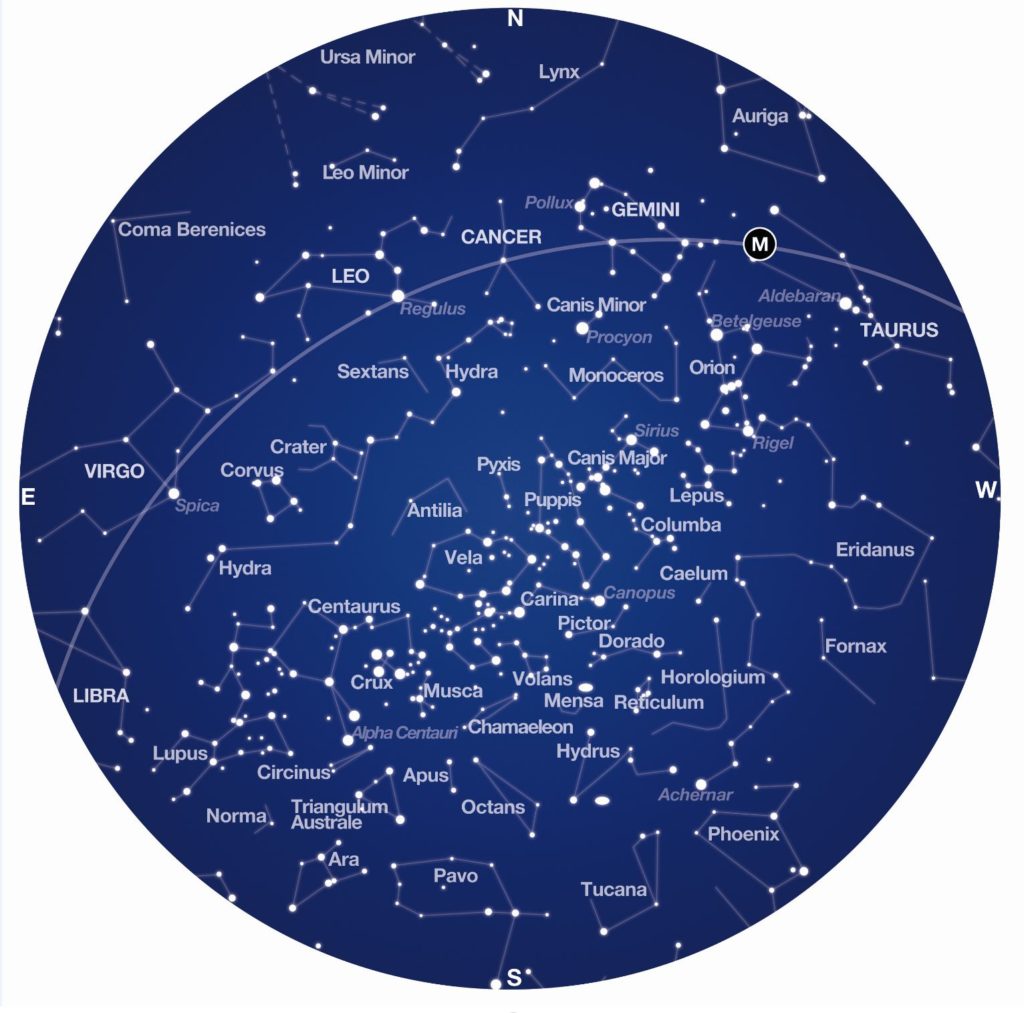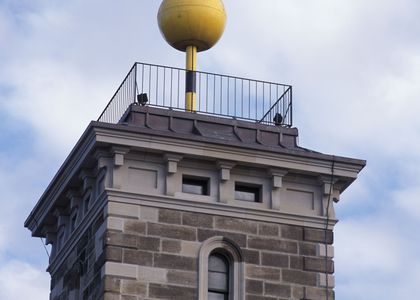
Monthly sky maps from the 2021 Australasian Sky Guide published by MAAS Media.
What’s in the sky this April?
Constellations
Constellations represent groupings of stars that have been given a name. For millennia they have been used as a tool to share significant cultural stories. Today, they also help astronomers delineate portions of the sky and are a navigational tool for locating astronomical objects. This month these constellations dominate the winter sky:
- Southern Cross & Two Pointer stars – This group of stars hang in the south-eastern sky during April evenings. The Southern Cross reaches its highest point in the sky, where it appears upright, at about 1am at the beginning of the month and by 10pm at the end of April. The Cross is the smallest of the 88 constellations and can be easily covered entirely by one hand. Below the Cross are the two bright Pointer stars, presently one above the other. A line drawn from Alpha Centauri towards Beta Centauri and onwards points towards the Cross. The Southern Cross is a modern constellation dating from the early 1500s.
- Orion – The Hunter is in the north-western sky and heading for the western horizon. Its likeness to a male figure was probably obvious to the earliest humans. The three stars of Orion’s belt at his waist separate his head & shoulders on the right from his sword and knees on the left. The well-known saucepan asterism consists of a base (Orion’s belt) and a handle (Orion’s sword) plus one additional star at the rim. With binoculars you will see a small hazy glow in the middle of the saucepan’s handle – this is the Orion Nebula, a starbirth cloud. The mythology of Orion is complex and often contradictory. However, he usually represents a tall, strong and handsome hunter.
- Leo – The Lion, one of the twelve constellations of the Zodiac, remains in the northern sky during April. The lion earned a place amongst the constellations for being a fierce and powerful beast. To the Greeks he was the lion of Nemea, killed by Hercules in the first of his twelve labours.
- Canis Minor – The Lesser Dog, is an obscure and small constellation usually ignored in the search for its dominant companion, Canis Major. On any April night high overhead you will see the very bright star Sirius in Canis Major. Facing north early in the evening, look below Sirius by slightly more than a handspan (with your hand at arm’s length) – the bright star here is Procyon in Canis Minor. And Procyon is just about all there is to the Lesser Dog! Like many constellations it looks nothing like its name. The star’s name comes form the Greek Prokyon meaning “before the Dog” and indeed it rises before bright Sirius and Canis Major from the latitudes of ancient Greece. Canis Minor and Canis Major are both Orion’s hunting dogs.
Planets
This month our evening planets are Venus and Mars. Jupiter & Saturn and Mercury appear in the morning sky. If you have trouble identifying planets from stars the Moon comes to your aid.
- Mars – is getting low in the north-east. Look below Orion for two reddish ‘stars’ – to the left is the star Aldebaran, the eye of Taurus the Bull, and to the right is Mars itself (slightly fainter). Mars moves from Taurus into Gemini in the last week of April. On April 17 the crescent Moon is below & left of Mars.
- Venus – returns to the evening sky in the last week of the month, and may just be visible as the Evening Star shortly after sunset.
- Mercury – begins the month very low in the eastern sky before dawn in the constellation of Aquarius. It soon moves into Pisces but by the middle of the month has dropped into the morning twilight.
- Jupiter & Saturn – the Giant planets are both in the eastern morning sky and both begin the month in Capricornus. Jupiter is brighter than Saturn. On the 6th the crescent Moon is above & right of Saturn, on the 7th it is between both planets (and maybe worth a photo) and by the 8th the Moon is below & right of Jupiter.
Moon
For the monthly movements of the moon, check out our Moon Phase Calendar.
Deep Sky
Explore the universe through your binoculars or telescope and take in some of the gems of the April sky. These look at their best with no Moon in the sky:
- Orion nebula – this is your last chance to see this starbirth cloud. It looks particularly good from dark rural locations. But even in a light polluted city its worth viewing.
- Jewel Box – this colourful cluster of stars in the Southern Cross returns to our skies for its winter passage.
- Messier 104, the Sombrero galaxy – this edge-on spiral galaxy appears as a oval smudge in most telescopes with a dark band (of dust & gas) splitting it in two. Discovered by Mechain not Messier this galaxy is 30 million light years away.
- Ghost of Jupiter – also known by its catalogue number of NGC3242 this planetary nebula in Hydra is the remains of a dying star that has shed its outer layers. In a telescope its apparent size is simialr to the planet Jupiter but in reality it is larger than our solar system. Our Sun is destined to look like this at the end of its life.
Other Events
In April 2021 also look out for:
- Daylight Saving time ends – on Sunday April 04 (Easter Sunday) at 03:00am for NSW, ACT, Victoria, Tasmania and South Australia all your timing devices need to go back 1 hour. Your computer and smartphone should change automatically but on other devices you will need to manually put the clock back.
- Supermoon – On April 27 there is a Supermoon. The Moon’s orbit about Earth is elliptical and this brings the Moon closer to and then further from Earth during each orbit. If the Moon’s closest point coincides with a Full Moon (or nearly so) we have a Supermoon. In fact, the definition is completely arbitrary but the Moon may look slightly larger on this night. The Moon is full at 01:32pm AEST on the 27th and is then at perigee early the next morning on April 28 at 01:24am. It rises for most Australian locations between 5pm and 7pm.
- Magellanic Clouds – It is 500 years since the death of Ferdinand Magellan. The Portuguese explorer’s expedition circumnavigated the world between 1519 and 1522 but Magellan himself was killed in the Phillipines on April 27, 1521. His name has been given to the Magellanic Clouds, two small nearby galaxies, which in April are seen in the south-western sky.
Learn More
Purchase the 2021 Australasian Sky Guide by Dr Nick Lomb, featuring an annual report of what’s in the sky and the latest astronomical findings. Produced by MAAS Media.
View the Star Map 04 April 2021, which shows the stars, constellations and planets visible in the night sky from anywhere in Australia
Check out these resources for getting started



Hello,
I saw a fascinating long line of slow moving star-like lights travelling south to North over Bondi Beach at about 5.25am this morning 13th April.
The didn’t flicker and seemed to be at the height of a flock of birds. They were in single file, unevenly spaced but moving at a constant speed. The speed was similar to what a slow falling parachuter might descend at.
Any ideas?
Many thanks
Kirsten
Kirsten, They were Elon Musk’s Starlink satellites. Please see my answer to Jacqueline below.